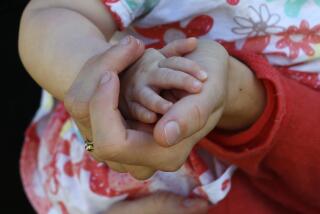Dads’ Help Seen Reducing Need for Day Care
- Share via
WASHINGTON — A large growth in the number of fathers taking care of their children while mothers work is holding down the need for day care, the Census Bureau said in a report released Friday.
The growing role of fathers has had another result too: helping to stem the rising number of children home alone after school, even as the number of working mothers increased, according to census officials.
“It’s the best-kept secret in American child care: the (number) of men who are primary care-givers for their kids,” said James Levine, director of The Fatherhood Project at the New York-based Families & Work Institute. “The reality is that a lot more men are doing this than we thought. It’s not glitzy and role-reversing, it’s necessary to do this.”
The study found that the proportion of families paying for child care fell from 40% in 1988 to 35% in 1991, a trend attributed primarily to the increase in care from fathers.
While 15% of preschoolers whose mothers work were cared for by their fathers in 1988, that figure rose to 20% over the next three years.
Census Bureau demographer Lynne M. Casper, one of the authors of the study, said the change was due mostly to economics and tight family budgets.
“They’re stretched to their limits now and they can’t afford to pay for day care,” she said. As more fathers became unemployed in the late 1980s, more were available to take care of kids.
And, Casper added, publicity about the poor quality of some day-care settings has led some parents to choose to juggle their shifts rather than trust their children to the care of others.
The study, which was the first to report an official number, said there were 1.6 million, or 8% of grade-school children with working mothers, who came home to empty houses.
A third of these children are under the age of 12 and the income of families did not make a difference in whether the child was likely to be left alone, the study found.
Casper cautioned that the figures, while they were the best available to date, were probably low, in part because many parents hesitate to admit that their children are home alone.
Census Bureau officials say they believe that the true number of latchkey children is closer to 5 million. The larger figure includes children who were in child care much less time than their mothers were at work.
The latchkey-child phenomenon has spawned its own support industry. Not only are there classes for children in how to take care of themselves at home, but many areas offer call-in lines for youngsters to dial when they’re lonely, afraid or just want to chat.
In some areas, especially metropolitan Washington with its high proportion of working mothers, the number of latchkey children may be higher.
More to Read
Sign up for Essential California
The most important California stories and recommendations in your inbox every morning.
You may occasionally receive promotional content from the Los Angeles Times.













